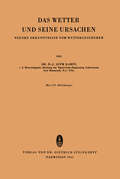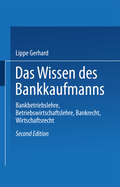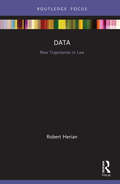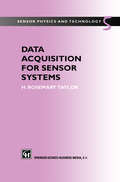- Table View
- List View
Das Wertpapiergeschäft in der Abschlussprüfung des Bankkaufmanns (Die Bankgeschäfte #2)
by Gert KrettekDas Wesen des Gußbetons: Eine Studie mit Hilfe von Laboratoriumsversuchen
by G. BethkeDieser Buchtitel ist Teil des Digitalisierungsprojekts Springer Book Archives mit Publikationen, die seit den Anfängen des Verlags von 1842 erschienen sind. Der Verlag stellt mit diesem Archiv Quellen für die historische wie auch die disziplingeschichtliche Forschung zur Verfügung, die jeweils im historischen Kontext betrachtet werden müssen. Dieser Titel erschien in der Zeit vor 1945 und wird daher in seiner zeittypischen politisch-ideologischen Ausrichtung vom Verlag nicht beworben.
Das Wesen des Lebens: Ordnung als wesentliche Eigenschaft der belebten Materie
by Gerhard von FrankenbergDieser Buchtitel ist Teil des Digitalisierungsprojekts Springer Book Archives mit Publikationen, die seit den Anfängen des Verlags von 1842 erschienen sind. Der Verlag stellt mit diesem Archiv Quellen für die historische wie auch die disziplingeschichtliche Forschung zur Verfügung, die jeweils im historischen Kontext betrachtet werden müssen. Dieser Titel erschien in der Zeit vor 1945 und wird daher in seiner zeittypischen politisch-ideologischen Ausrichtung vom Verlag nicht beworben.
Das Wesen des Lichts: Vortrag Gehalten in der Hauptversammlung der Kaiser-Wilhelm-Gesellschaft am 28. Oktober 1919
by Max PlanckDieser Buchtitel ist Teil des Digitalisierungsprojekts Springer Book Archives mit Publikationen, die seit den Anfängen des Verlags von 1842 erschienen sind. Der Verlag stellt mit diesem Archiv Quellen für die historische wie auch die disziplingeschichtliche Forschung zur Verfügung, die jeweils im historischen Kontext betrachtet werden müssen. Dieser Titel erschien in der Zeit vor 1945 und wird daher in seiner zeittypischen politisch-ideologischen Ausrichtung vom Verlag nicht beworben.
Das Wesen des Lichts: Vortrag Gehalten in der Hauptversammlung der Kaiser-Wilhelm-Gesellschaft am 28. Oktober 1919
by Max PlanckDieser Buchtitel ist Teil des Digitalisierungsprojekts Springer Book Archives mit Publikationen, die seit den Anfängen des Verlags von 1842 erschienen sind. Der Verlag stellt mit diesem Archiv Quellen für die historische wie auch die disziplingeschichtliche Forschung zur Verfügung, die jeweils im historischen Kontext betrachtet werden müssen. Dieser Titel erschien in der Zeit vor 1945 und wird daher in seiner zeittypischen politisch-ideologischen Ausrichtung vom Verlag nicht beworben.
Das Wetter und Seine Ursachen: Neuere Erkenntnisse vom Wettergeschehen (Wissenschaftliche Forschungsberichte)
by H.-J. AufmKampeDas vorliegende Buch soll dem Leser eInIge Erkenntnisse mitteilen, die über die Ursachen und das Wesen des Wettergeschehens während der letzten zwei Jahrzehnte gewonnen wurden. Es erhebt dem Umfang entspre chend nicht den geringsten Anspruch auf Vollständigkeit. Ich war aber der Meinung, daß es von Zeit zu Zeit notwendig ist, dem Studenten der Meteoro logie und den intereseierten Laien wichtige Arbeiten, die auf dem Gebiet der Physik der Atmosphäre geschrieben wurden, in gedrängter Form zusam menzufassen; da es meistens, vor allem nach dem Krieg, wo so viele Bücher zerstört wurden, für den einzelncn unmöglich ist, alle erschienenen Arbeiten selbst zu lesen. Weiterhin schien es mir ratsam, ein Buch zu schreiben, das so objektiv wie möglich, die Ansichten wiedergibt, die an den verschiedenen meteorologischen Forschungszentren vertreten werden. Dies gilt besonders für die Zyklonenentstehung und Fortpflanzung. In jeder Theorie steckt mei~ stens ein mehr oder minder großer Kern Wahrheit, und diese Kerne, mosaik artig zusammengesetzt, werden am ehesten dem Bild des komplexen Wetter geschehens gerecht werden. Um den Kreis der Leser nicht von vornherein einzuschränken, mußte ich auf die rein theoretisch-mathematischen Arbeiten verzichten, obwohl diese vielleicht sogar am meisten zu den Fortschritten der Physik, zu der ja auch die Meteorologie gehört, beitragen. Das Manuskript lag im wesentlichen bereits 1944 vor. Durch Kriegs und Nachkriegsereignisse wurde die Herausgabe aber bis jetzt verzögert. Dadurch konnte auch Nachkriegsliteratur berücksichtigt werden. Daß das Bändchen trotz der schwierigen Nachkriegsverhältnisse überhaupt noch gedruckt wurde, verdanke ich einzig und allein dem Verlag Dr.
Das Wissen des Bankkaufmanns: Bankbetriebslehre, Betriebswirtschaftslehre, Bankrecht, Wirtschaftsrecht
by Lippe GerhardDas Wissen für Bankkaufleute: Bankbetriebslehre Betriebswirtschaftslehre Bankrecht Wirtschaftsrecht Rechnungswesen, Organisation, Datenverarbeitung
by Gerhard LippeDas Wolhynische Fieber
by Paul JungmannDieser Buchtitel ist Teil des Digitalisierungsprojekts Springer Book Archives mit Publikationen, die seit den Anfängen des Verlags von 1842 erschienen sind. Der Verlag stellt mit diesem Archiv Quellen für die historische wie auch die disziplingeschichtliche Forschung zur Verfügung, die jeweils im historischen Kontext betrachtet werden müssen. Dieser Titel erschien in der Zeit vor 1945 und wird daher in seiner zeittypischen politisch-ideologischen Ausrichtung vom Verlag nicht beworben.
Das Wuppertal Haus: Bauen und Wohnen nach dem Mips-Konzept
by Tönis Käö Friedrich Schmidt-Bleek Wolfram HunckeDas Zweite - kompakt: Querschnittsbereiche - GK 2 (Springer-Lehrbuch)
by Klaus-Peter W. Schaps Oliver Kessler Ulrich FetznerKeine Panik vor dem "Hammerexamen"! Zur effizienten Vorbereitung auf das 2. Staatsexamen gibt es jetzt die neue Prüfungsrepetitorienreihe aus dem Hause Springer. Studenten schrieben für Studenten - knapp, einprägsam, studenten- und prüfungsgerecht. Jedes von Studenten verfasste Kapitel wurde von Fachärzten gegengelesen und korrigiert. Gemeinsam entwickelten sie die ausgefeilte, anschauliche Didaktik. Alle Grundlagen sind knapp formuliert, alle Inhalte auf dem Stand des neuen GK (2). Alle Krankheitsbilder finden sich in Band I-VIII, alle Gesundheitsstörungen inkl. Differenzialdiagnosen und Wiederholung der Diagnostik und Therapie in Band IX.
Das Zwickelverfahren: ein beitrag zur baustatik
by Arnold MoserDieser Buchtitel ist Teil des Digitalisierungsprojekts Springer Book Archives mit Publikationen, die seit den Anfängen des Verlags von 1842 erschienen sind. Der Verlag stellt mit diesem Archiv Quellen für die historische wie auch die disziplingeschichtliche Forschung zur Verfügung, die jeweils im historischen Kontext betrachtet werden müssen. Dieser Titel erschien in der Zeit vor 1945 und wird daher in seiner zeittypischen politisch-ideologischen Ausrichtung vom Verlag nicht beworben.
Das Zwillingsparadoxon (essentials)
by Helmut GüntherDie bewegte Uhr geht nach. – Zwei Zwillinge bewegen sich in entgegengesetzter Richtung. Beide beobachten, dass die Uhr des anderen nachgeht. Dann kommen sie wieder zusammen und stellen fest: Jünger ist, wer seine Geschwindigkeit geändert hat. Eine elementare Erklärung dafür folgt aus einer Kette von Ungleichungen auf der Basis der Zeitdilatation. Mit Hilfe der Definition einer absoluten Gleichzeitigkeit finden wir eine weitere, einfache Erklärung. Hierbei ist es wichtig, den definitorischen Charakter der Gleichzeitigkeit zu verstehen. Alternativ zu Einsteins Herleitung formulieren wir einen anschaulichen Zugang zur Speziellen Relativitätstheorie. Dabei können wir über die Gleichzeitigkeit frei verfügen und lösen das Paradoxon sowohl mit der Lorentz-Transformation als auch bei absoluter Gleichzeitigkeit.
Das Zwillingsparadoxon unter Berücksichtigung der Gravitation (essentials)
by Helmut GüntherDie bewegte Uhr und eine Uhr im Gravitationsfeld gehen nach. Das berühmte Paradoxon von den Zwillingen, die sich erst voneinander entfernen und dann wieder zusammenkommen, untersuchen wir zunächst im speziell-relativistischen Gedankenexperiment, also ohne Gravitation. Der Zwilling, der seinen Bruder mit einer höheren Geschwindigkeit wieder einholt, bleibt am Ende der jüngere, was sich mit der sog. Zwillingsungleichung einfach verifizieren lässt.Die Gravitation kann prinzipiell nicht abgeschirmt werden. Ihren Einfluss auf den Gang einer Uhr verstehen wir mit einem Gedankenexperiment von V. Müller. Während die Zwillinge betragsmäßig immer dieselbe Geschwindigkeit zueinander besitzen, gelangen sie aber bei ihrer Bewegung durch den Raum in die Nähe verschiedener Massen, so dass sie unterschiedlicher Gravitation ausgesetzt sind. Das kann dazu führen, dass am Ende der zurückkehrende Zwilling sogar der ältere ist.
Data: New Trajectories in Law (New Trajectories in Law)
by Robert HerianThis book explores the phenomenon of data – big and small – in the contemporary digital, informatic and legal-bureaucratic context. Challenging the way in which legal interest in data has focused on rights and privacy concerns, this book examines the contestable, multivocal and multifaceted figure of the contemporary data subject. The book analyses "data" and "personal data" as contemporary phenomena, addressing the data realms, such as stores, institutions, systems and networks, out of which they emerge. It interrogates the role of law, regulation and governance in structuring both formal and informal definitions of the data subject, and disciplining data subjects through compliance with normative standards of conduct. Focusing on the ‘personal’ in and of data, the book pursues a re-evaluation of the nature, role and place of the data subject qua legal subject in on and offline societies: one that does not begin and end with the inviolability of individual rights but returns to more fundamental legal principles suited to considerations of personhood, such as stewardship, trust, property and contract. The book’s concern with the production, use, abuse and alienation of personal data within the context of contemporary communicative capitalism will appeal to scholars and students of law, science and technology studies, and sociology; as well as those with broader political interests in this area.
Data: New Trajectories in Law (New Trajectories in Law)
by Robert HerianThis book explores the phenomenon of data – big and small – in the contemporary digital, informatic and legal-bureaucratic context. Challenging the way in which legal interest in data has focused on rights and privacy concerns, this book examines the contestable, multivocal and multifaceted figure of the contemporary data subject. The book analyses "data" and "personal data" as contemporary phenomena, addressing the data realms, such as stores, institutions, systems and networks, out of which they emerge. It interrogates the role of law, regulation and governance in structuring both formal and informal definitions of the data subject, and disciplining data subjects through compliance with normative standards of conduct. Focusing on the ‘personal’ in and of data, the book pursues a re-evaluation of the nature, role and place of the data subject qua legal subject in on and offline societies: one that does not begin and end with the inviolability of individual rights but returns to more fundamental legal principles suited to considerations of personhood, such as stewardship, trust, property and contract. The book’s concern with the production, use, abuse and alienation of personal data within the context of contemporary communicative capitalism will appeal to scholars and students of law, science and technology studies, and sociology; as well as those with broader political interests in this area.
Data Acquisition for Sensor Systems
by H.R. Taylor'Data acquisition' is concerned with taking one or more analogue signals and converting them to digital form with sufficient accu racy and speed to be ready for processing by a computer. The increasing use of computers makes this an expanding field, and it is important that the conversion process is done correctly because information lost at this stage can never be regained, no matter how good the computation. The old saying - garbage in, garbage out - is very relevant to data acquisition, and so every part of the book contains a discussion of errors: where do they come from, how large are they, and what can be done to reduce them? The book aims to treat the data acquisition process in depth with less detailed chapters on the fundamental principles of measure ment, sensors and signal conditioning. There is also a chapter on software packages, which are becoming increasingly popular. This is such a rapidly changing topic that any review of available pro grams is bound to be out of date before the book reaches the read ers. For this reason, I have described the data handling which is available in various types of program and left it to the reader to select from whatever is on the market at the time.
Data Analysis: Statistical and Computational Methods for Scientists and Engineers
by Siegmund BrandtThe fourth edition of this successful textbook presents a comprehensive introduction to statistical and numerical methods for the evaluation of empirical and experimental data. Equal weight is given to statistical theory and practical problems. The concise mathematical treatment of the subject matter is illustrated by many examples and for the present edition a library of Java programs has been developed. It comprises methods of numerical data analysis and graphical representation as well as many example programs and solutions to programming problems.The book is conceived both as an introduction and as a work of reference. In particular it addresses itself to students, scientists and practitioners in science and engineering as a help in the analysis of their data in laboratory courses, in working for bachelor or master degrees, in thesis work, and in research and professional work.
Data Analysis: Statistical and Computational Methods for Scientists and Engineers
by Siegmund BrandtBridging the gap between statistical theory and physical experiment, this is a thorough introduction to the statistical methods used in the experimental physical sciences and to the numerical methods used to implement them. The treatment emphasises concise but rigorous mathematics but always retains its focus on applications. Readers are assumed to have a sound basic knowledge of differential and integral calculus and some knowledge of vectors and matrices. After an introduction to probability, random variables, computer generation of random numbers and important distributions, the book turns to statistical samples, the maximum likelihood method, and the testing of statistical hypotheses. The discussion concludes with several important statistical methods: least squares, analysis of variance, polynomial regression, and analysis of time series. Appendices provide the necessary methods of matrix algebra, combinatorics, and many sets of useful algorithms and formulae.
Data Analysis and Chemometrics for Metabolomics
by Richard G. BreretonUnderstand new modes of analysing metabolomic data Metabolomics is the study of metabolites, small molecules and chemical substrates within cells or larger structures which collectively make up the metabolome. The field of metabolomics stands to benefit enormously from chemometrics, an approach which brings advanced statistical techniques to bear on data of this kind. Data Analysis and Chemometrics for Metabolomics constitutes an accessible introduction to chemometric techniques and their applications in the field of metabolomics. Thoroughly and accessibly written by a leading expert in chemometrics, and printed in full-colour, it brings robust data analysis into conversation with the metabolomic field to the immense benefit of practitioners. Data Analysis and Chemometrics for Metabolomics readers will also find: Statistical insights into the nature of metabolomic hypothesis testing, validation, and more All metabolomics data sets from the book on a companion website Case studies from human, animal, plant and bacterial biology Data Analysis and Chemometrics for Metabolomics is ideal for practitioners in the life sciences, clinical sciences and chemistry, as well as metabolomics researchers or developers of research instruments looking to apply cutting-edge analytical techniques, and statisticians developing methods to design experiments and analyse large datasets of clinical and biological origin.
Data Analysis and Chemometrics for Metabolomics
by Richard G. BreretonUnderstand new modes of analysing metabolomic data Metabolomics is the study of metabolites, small molecules and chemical substrates within cells or larger structures which collectively make up the metabolome. The field of metabolomics stands to benefit enormously from chemometrics, an approach which brings advanced statistical techniques to bear on data of this kind. Data Analysis and Chemometrics for Metabolomics constitutes an accessible introduction to chemometric techniques and their applications in the field of metabolomics. Thoroughly and accessibly written by a leading expert in chemometrics, and printed in full-colour, it brings robust data analysis into conversation with the metabolomic field to the immense benefit of practitioners. Data Analysis and Chemometrics for Metabolomics readers will also find: Statistical insights into the nature of metabolomic hypothesis testing, validation, and more All metabolomics data sets from the book on a companion website Case studies from human, animal, plant and bacterial biology Data Analysis and Chemometrics for Metabolomics is ideal for practitioners in the life sciences, clinical sciences and chemistry, as well as metabolomics researchers or developers of research instruments looking to apply cutting-edge analytical techniques, and statisticians developing methods to design experiments and analyse large datasets of clinical and biological origin.
Data Analysis and Classification: Methods and Applications (Studies in Classification, Data Analysis, and Knowledge Organization)
by Krzysztof Jajuga Krzysztof Najman Marek WalesiakThis volume gathers peer-reviewed contributions that address a wide range of recent developments in the methodology and applications of data analysis and classification tools in micro and macroeconomic problems. The papers were originally presented at the 29th Conference of the Section on Classification and Data Analysis of the Polish Statistical Association, SKAD 2020, held in Sopot, Poland, September 7–9, 2020. Providing a balance between methodological contributions and empirical papers, the book is divided into five parts focusing on methodology, finance, economics, social issues and applications dealing with COVID-19 data. It is aimed at a wide audience, including researchers at universities and research institutions, graduate and doctoral students, practitioners, data scientists and employees in public statistical institutions.
Data Analysis and Presentation Skills: An Introduction for the Life and Medical Sciences
by Jackie WillisData Analysis and Presentation Skills: An Introduction for the Life and Medical Sciences is an invaluable text allowing students to develop appropriate key skills when designing experiments, generating results, analysing data and ultimately presenting findings to academics and referees. Taking a hands-on approach, each of these key areas is introduced clearly and carefully, showing how to access and evaluate information using a variety of resources. Basic analytical theory is gradually introduced alongside practical applications to enhance student understanding. The reader is shown how to present data in charts using Microsoft Excel and statistical analysis is carefully explained showing clearly how to manipulate data in spreadsheets and analyse the results using commonly used tests. A section is also included on the use of PowerPoint as well as giving advice on how to prepare a short talk or seminar. Includes numerous relevant examples and case studies drawn from the Life Sciences Guidance on how to complete and present practical and project work through to postgraduate dissertation. Clear step-by-step introduction to Microsoft Excel, presentation skills and statistical analysis. Invaluable for all students within the Life and Medical Sciences






















